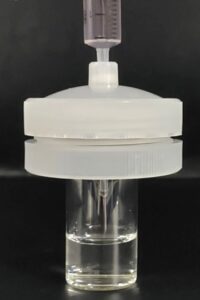Injectable Water Filtration System Could Improve Access to Clean Drinking Water
Injectable Water Filtration System Could Improve Access to Clean Drinking Water The University of Texas at Austin


AUSTIN, Texas — New Portable Water Filtration System Aims to Address Global Water Crisis
More than 2 billion people, approximately a quarter of the world’s population, lack access to clean drinking water. A new, portable and affordable water filtration solution created by researchers at The University of Texas at Austin aims to change that.
Introduction
The new system collects dirty water with a syringe and injects it into a hydrogel filter that weeds out nearly all tiny particles. It also offers significant advantages in cost, simplicity, effectiveness, and sustainability compared with existing commercial options, giving users the ability to easily decontaminate water from nearby streams and rivers and make it drinkable.
Sustainable Development Goals (SDGs)
The pressing concern of particle-polluted water, particularly in remote and underdeveloped regions where people frequently rely on contaminated water sources for consumption, demands immediate attention and recognition. Our system, with its high efficiency in removing diverse types of particles, offers an attractive yet practical solution in improving freshwater availability. This aligns with the United Nations’ Sustainable Development Goals to improve drinking water standards and sanitation worldwide.
Research Details
The research is published in Nature Sustainability.

Today’s options for portable water filtration of tiny particles mostly consist of filter paper and microporous membranes. According to the research, these devices filter out about 40% and 80% of particles larger than 10 nanometers, respectively. This new system catches close to 100% of these particles.
The main innovation of this system is an intertwined web of nanocellulose fibers that catches particles while allowing the newly cleaned water to pass through.
Simple and User-Friendly
All the user has to do is take the syringe to the nearest water source, pull out the water, and inject it through the filter. The system takes care of the rest, producing clean, drinkable water.
Testing and Sustainability
The filter system has been tested with several types of water sources, including muddy water, river water, and water contaminated with microplastics. The hydrogel films are biodegradable and can be used up to 30 times before they need to be replaced.
Future Development
The research team has tested the technology using syringes as large as 1.5 liters, which accounts for about 40% of an individual’s daily drinking water needs. They plan to continue developing the technology to use it at larger scales to tackle global drinking water needs.
Conclusion
The reality is a large percentage of the world’s population lacks access to safe drinking water, even in places where fresh water sources are available. There is an urgent need for simple, universal, and efficient materials and devices for purifying particle-contaminated water, which should be able to help people around the world obtain clean water.
Team members on the project also include collaborators from Northeast Forestry University, Shanghai Tech University, and Tsinghua University in China.
SDGs, Targets, and Indicators
1. Which SDGs are addressed or connected to the issues highlighted in the article?
- SDG 6: Clean Water and Sanitation
The article highlights the issue of lack of access to clean drinking water, which is directly connected to SDG 6 – Clean Water and Sanitation.
2. What specific targets under those SDGs can be identified based on the article’s content?
- Target 6.1: By 2030, achieve universal and equitable access to safe and affordable drinking water for all.
- Target 6.3: By 2030, improve water quality by reducing pollution, eliminating dumping and minimizing release of hazardous chemicals and materials, halving the proportion of untreated wastewater, and substantially increasing recycling and safe reuse globally.
The article discusses the development of a portable and affordable water filtration solution that aims to provide clean drinking water to those who lack access. This aligns with Target 6.1 of SDG 6. Additionally, the filtration system removes particles from water sources, contributing to Target 6.3’s objective of improving water quality.
3. Are there any indicators mentioned or implied in the article that can be used to measure progress towards the identified targets?
- Indicator 6.1.1: Proportion of population using safely managed drinking water services.
- Indicator 6.3.2: Proportion of bodies of water with good ambient water quality.
The article does not explicitly mention any indicators. However, the development of a portable water filtration system can contribute to the achievement of Indicator 6.1.1 by increasing the proportion of the population using safely managed drinking water services. Additionally, the removal of particles from water sources can contribute to Indicator 6.3.2 by improving the ambient water quality of those sources.
4. Table: SDGs, Targets, and Indicators
| SDGs | Targets | Indicators |
|---|---|---|
| SDG 6: Clean Water and Sanitation | Target 6.1: By 2030, achieve universal and equitable access to safe and affordable drinking water for all. | Indicator 6.1.1: Proportion of population using safely managed drinking water services. |
| SDG 6: Clean Water and Sanitation | Target 6.3: By 2030, improve water quality by reducing pollution, eliminating dumping and minimizing release of hazardous chemicals and materials, halving the proportion of untreated wastewater, and substantially increasing recycling and safe reuse globally. | Indicator 6.3.2: Proportion of bodies of water with good ambient water quality. |
The table summarizes the relevant SDGs, targets, and indicators identified in the article. SDG 6 addresses the issue of lack of access to clean drinking water, with specific targets and indicators related to achieving universal access to safe drinking water and improving water quality.
Behold! This splendid article springs forth from the wellspring of knowledge, shaped by a wondrous proprietary AI technology that delved into a vast ocean of data, illuminating the path towards the Sustainable Development Goals. Remember that all rights are reserved by SDG Investors LLC, empowering us to champion progress together.
Source: news.utexas.edu

Join us, as fellow seekers of change, on a transformative journey at https://sdgtalks.ai/welcome, where you can become a member and actively contribute to shaping a brighter future.







